Analysis of HRM Strategies and Practices: Royal Dutch Shell Report
VerifiedAdded on 2022/12/28
|16
|4131
|2
Report
AI Summary
This report provides a comprehensive analysis of the Human Resource Management (HRM) strategies and practices employed by Royal Dutch Shell, a multinational oil and gas company. It begins with an introduction to HRM concepts and strategic approaches, followed by an examination of how regional and national cultures impact HRM practices within the organization. The report then delves into Royal Dutch Shell's organizational model of employment and the various organizational levers it utilizes. A key section contrasts Storey's 27 points of difference between HRM and Personnel Management, highlighting the shift towards a more strategic and integrated approach. The report also addresses the complexities of hiring and firing in both local and transnational cultural contexts, as well as differences in employment laws. Furthermore, it provides corporate examples of firms using effective HR practices and concludes with recommendations for employers to ensure organizational performance, offering insights into how Royal Dutch Shell can optimize its HRM strategies.
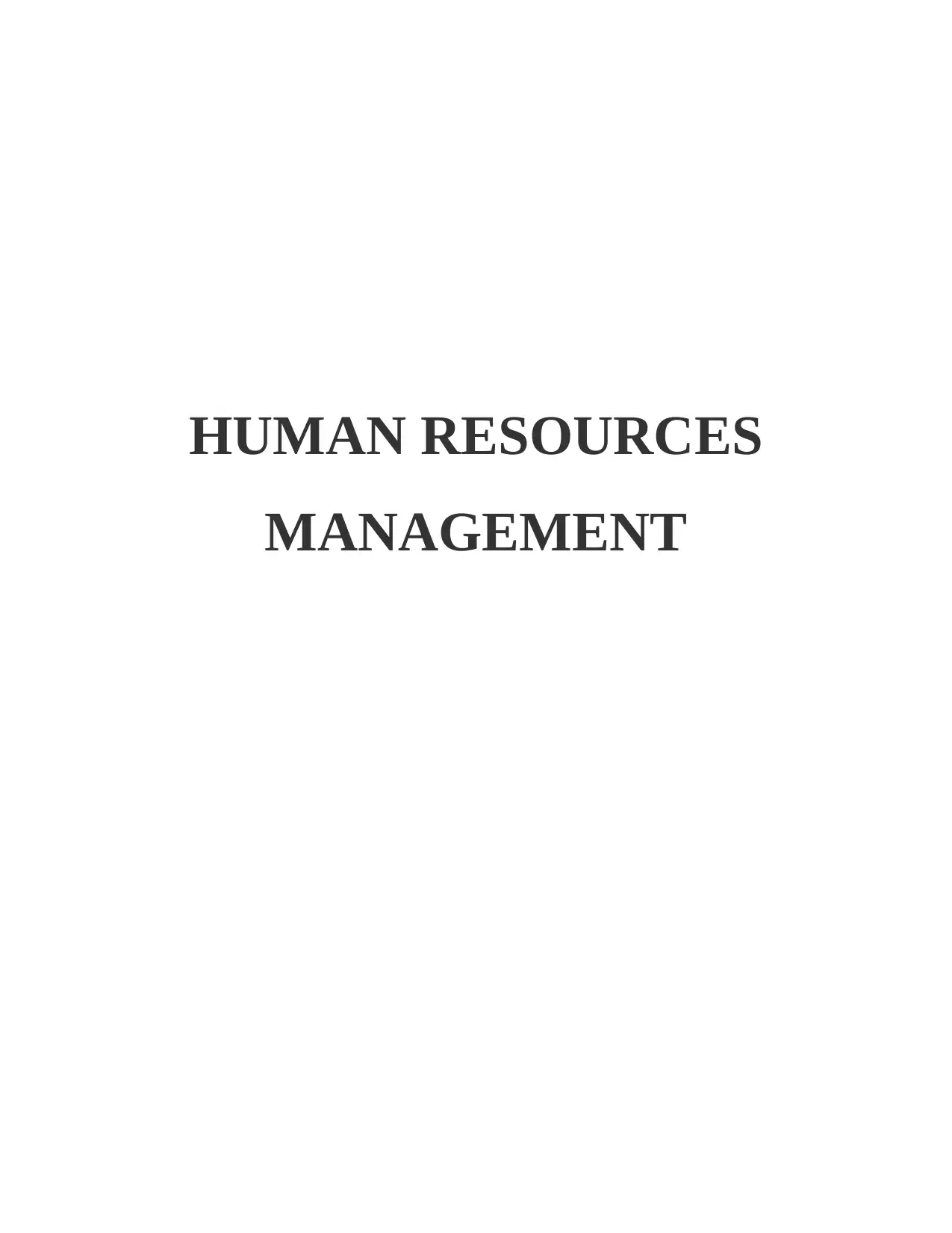
HUMAN RESOURCES
MANAGEMENT
MANAGEMENT
Paraphrase This Document
Need a fresh take? Get an instant paraphrase of this document with our AI Paraphraser
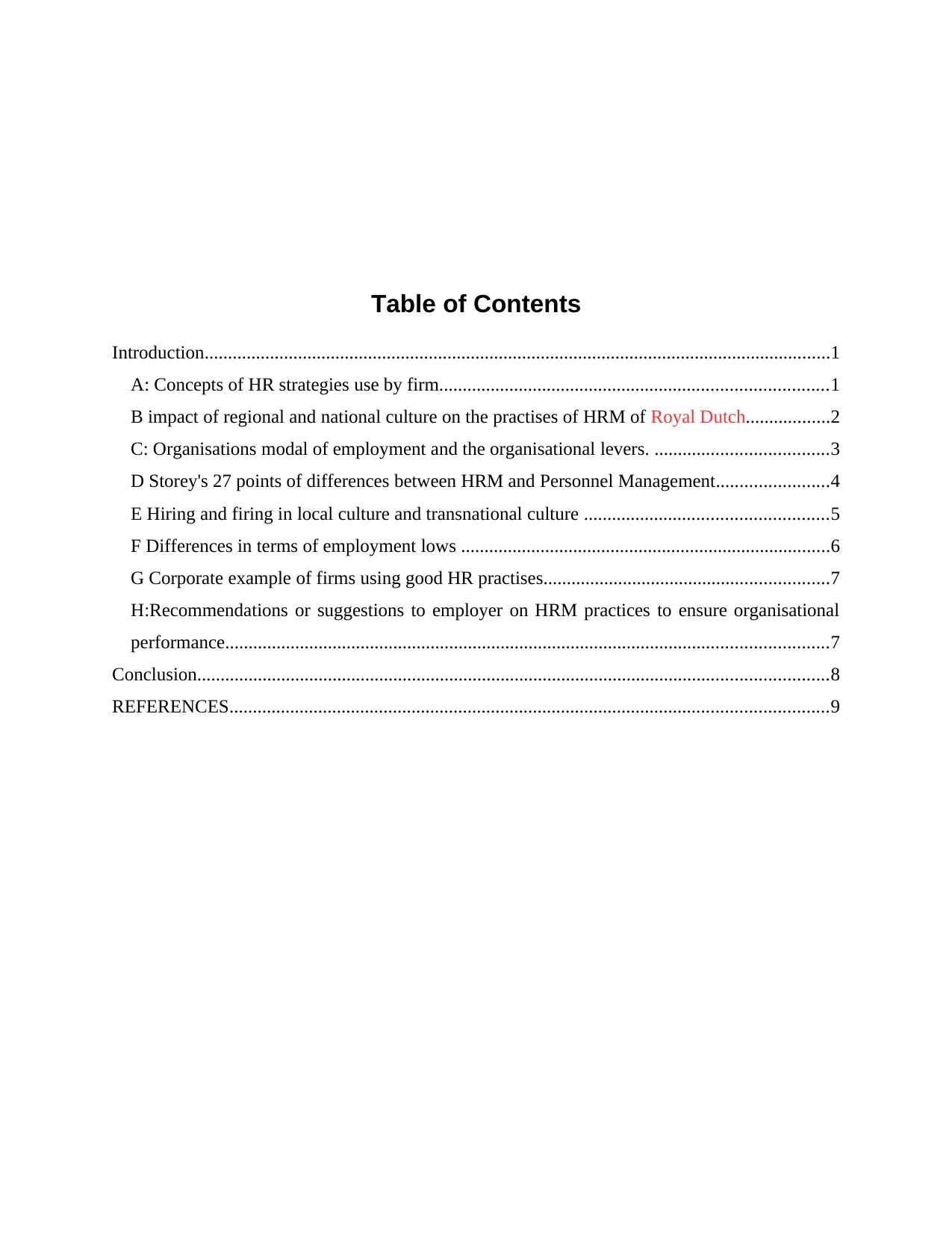
Table of Contents
Introduction......................................................................................................................................1
A: Concepts of HR strategies use by firm...................................................................................1
B impact of regional and national culture on the practises of HRM of Royal Dutch..................2
C: Organisations modal of employment and the organisational levers. .....................................3
D Storey's 27 points of differences between HRM and Personnel Management........................4
E Hiring and firing in local culture and transnational culture ....................................................5
F Differences in terms of employment lows ...............................................................................6
G Corporate example of firms using good HR practises.............................................................7
H:Recommendations or suggestions to employer on HRM practices to ensure organisational
performance.................................................................................................................................7
Conclusion.......................................................................................................................................8
REFERENCES................................................................................................................................9
Introduction......................................................................................................................................1
A: Concepts of HR strategies use by firm...................................................................................1
B impact of regional and national culture on the practises of HRM of Royal Dutch..................2
C: Organisations modal of employment and the organisational levers. .....................................3
D Storey's 27 points of differences between HRM and Personnel Management........................4
E Hiring and firing in local culture and transnational culture ....................................................5
F Differences in terms of employment lows ...............................................................................6
G Corporate example of firms using good HR practises.............................................................7
H:Recommendations or suggestions to employer on HRM practices to ensure organisational
performance.................................................................................................................................7
Conclusion.......................................................................................................................................8
REFERENCES................................................................................................................................9
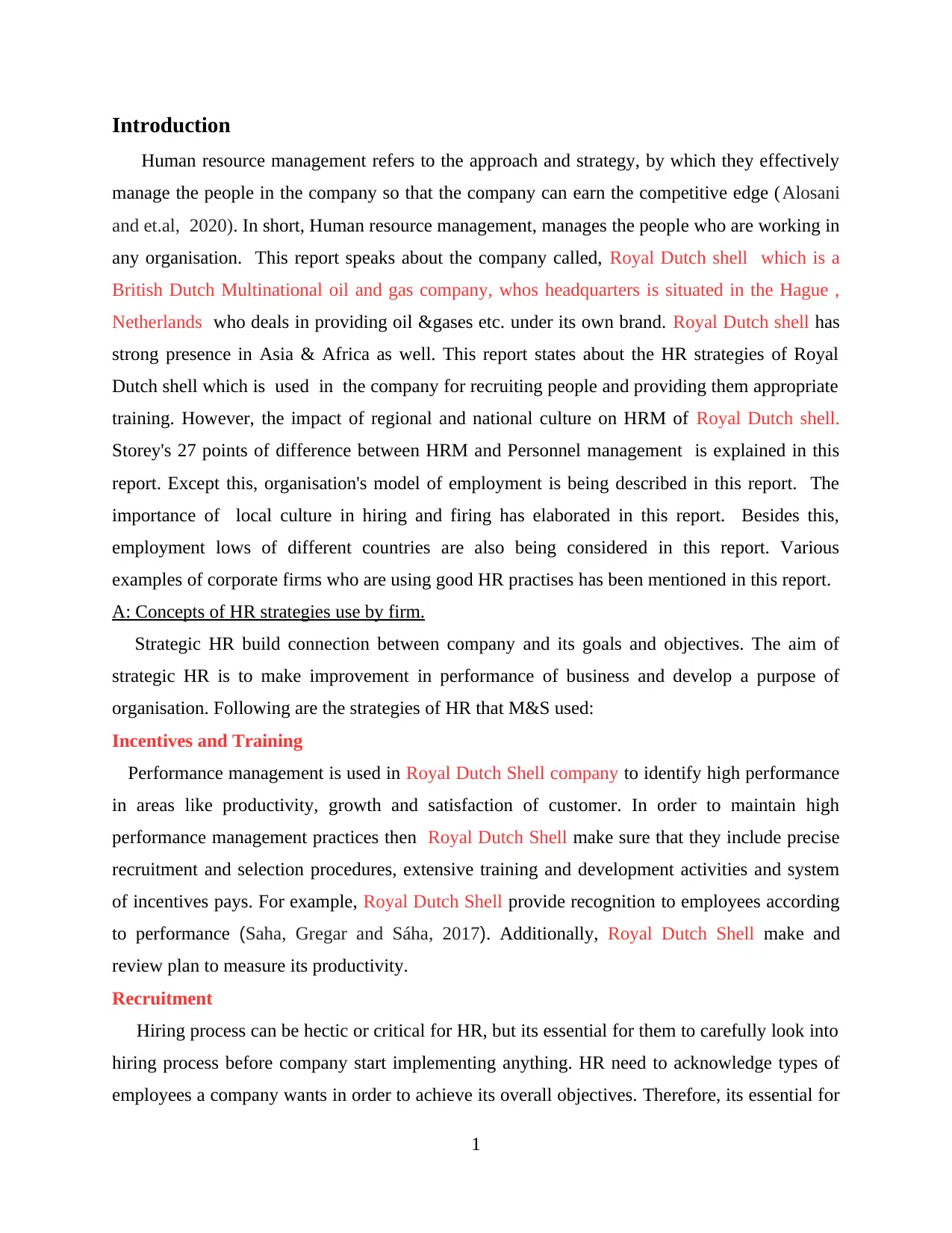
Introduction
Human resource management refers to the approach and strategy, by which they effectively
manage the people in the company so that the company can earn the competitive edge (Alosani
and et.al, 2020). In short, Human resource management, manages the people who are working in
any organisation. This report speaks about the company called, Royal Dutch shell which is a
British Dutch Multinational oil and gas company, whos headquarters is situated in the Hague ,
Netherlands who deals in providing oil &gases etc. under its own brand. Royal Dutch shell has
strong presence in Asia & Africa as well. This report states about the HR strategies of Royal
Dutch shell which is used in the company for recruiting people and providing them appropriate
training. However, the impact of regional and national culture on HRM of Royal Dutch shell.
Storey's 27 points of difference between HRM and Personnel management is explained in this
report. Except this, organisation's model of employment is being described in this report. The
importance of local culture in hiring and firing has elaborated in this report. Besides this,
employment lows of different countries are also being considered in this report. Various
examples of corporate firms who are using good HR practises has been mentioned in this report.
A: Concepts of HR strategies use by firm.
Strategic HR build connection between company and its goals and objectives. The aim of
strategic HR is to make improvement in performance of business and develop a purpose of
organisation. Following are the strategies of HR that M&S used:
Incentives and Training
Performance management is used in Royal Dutch Shell company to identify high performance
in areas like productivity, growth and satisfaction of customer. In order to maintain high
performance management practices then Royal Dutch Shell make sure that they include precise
recruitment and selection procedures, extensive training and development activities and system
of incentives pays. For example, Royal Dutch Shell provide recognition to employees according
to performance (Saha, Gregar and Sáha, 2017). Additionally, Royal Dutch Shell make and
review plan to measure its productivity.
Recruitment
Hiring process can be hectic or critical for HR, but its essential for them to carefully look into
hiring process before company start implementing anything. HR need to acknowledge types of
employees a company wants in order to achieve its overall objectives. Therefore, its essential for
1
Human resource management refers to the approach and strategy, by which they effectively
manage the people in the company so that the company can earn the competitive edge (Alosani
and et.al, 2020). In short, Human resource management, manages the people who are working in
any organisation. This report speaks about the company called, Royal Dutch shell which is a
British Dutch Multinational oil and gas company, whos headquarters is situated in the Hague ,
Netherlands who deals in providing oil &gases etc. under its own brand. Royal Dutch shell has
strong presence in Asia & Africa as well. This report states about the HR strategies of Royal
Dutch shell which is used in the company for recruiting people and providing them appropriate
training. However, the impact of regional and national culture on HRM of Royal Dutch shell.
Storey's 27 points of difference between HRM and Personnel management is explained in this
report. Except this, organisation's model of employment is being described in this report. The
importance of local culture in hiring and firing has elaborated in this report. Besides this,
employment lows of different countries are also being considered in this report. Various
examples of corporate firms who are using good HR practises has been mentioned in this report.
A: Concepts of HR strategies use by firm.
Strategic HR build connection between company and its goals and objectives. The aim of
strategic HR is to make improvement in performance of business and develop a purpose of
organisation. Following are the strategies of HR that M&S used:
Incentives and Training
Performance management is used in Royal Dutch Shell company to identify high performance
in areas like productivity, growth and satisfaction of customer. In order to maintain high
performance management practices then Royal Dutch Shell make sure that they include precise
recruitment and selection procedures, extensive training and development activities and system
of incentives pays. For example, Royal Dutch Shell provide recognition to employees according
to performance (Saha, Gregar and Sáha, 2017). Additionally, Royal Dutch Shell make and
review plan to measure its productivity.
Recruitment
Hiring process can be hectic or critical for HR, but its essential for them to carefully look into
hiring process before company start implementing anything. HR need to acknowledge types of
employees a company wants in order to achieve its overall objectives. Therefore, its essential for
1
⊘ This is a preview!⊘
Do you want full access?
Subscribe today to unlock all pages.

Trusted by 1+ million students worldwide
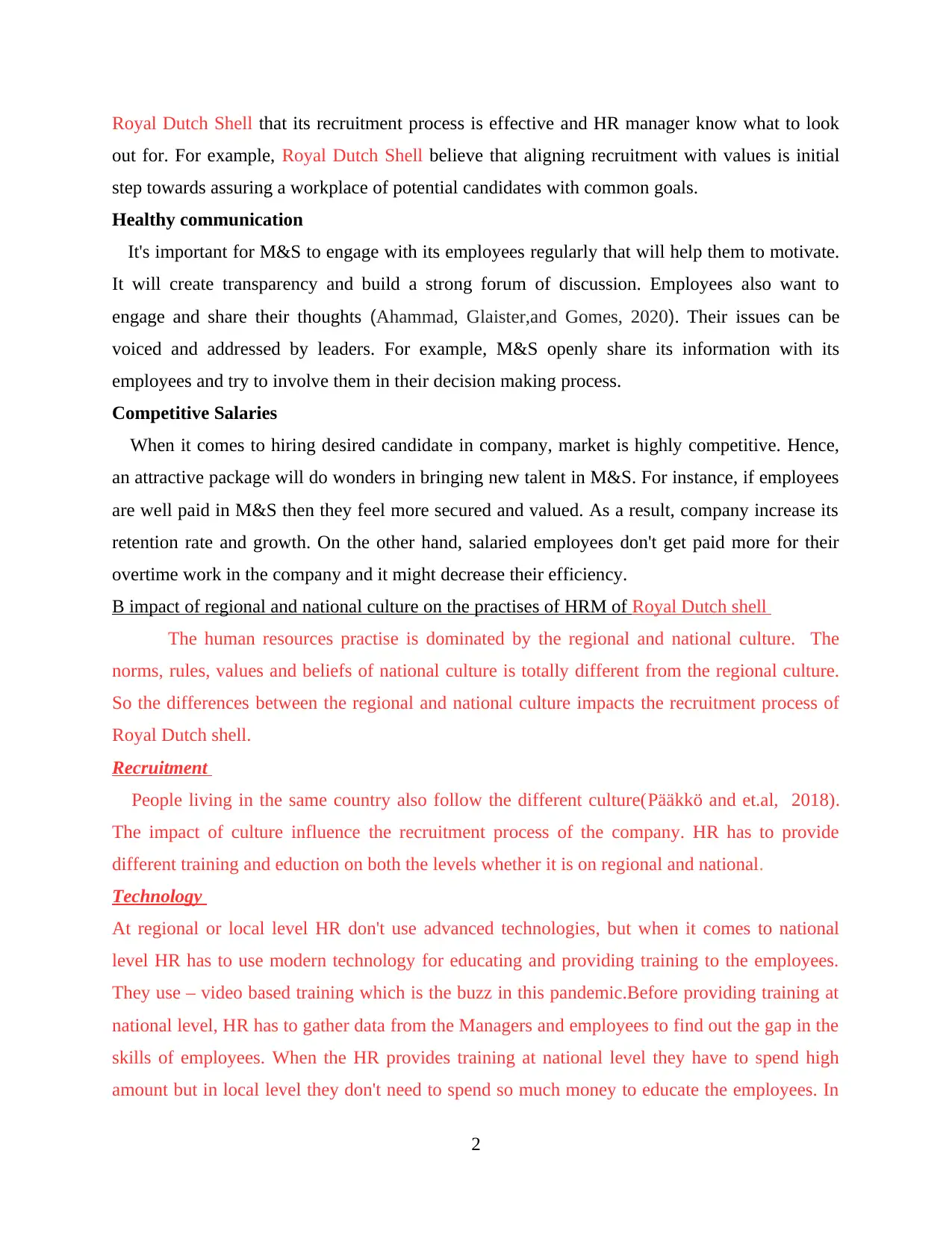
Royal Dutch Shell that its recruitment process is effective and HR manager know what to look
out for. For example, Royal Dutch Shell believe that aligning recruitment with values is initial
step towards assuring a workplace of potential candidates with common goals.
Healthy communication
It's important for M&S to engage with its employees regularly that will help them to motivate.
It will create transparency and build a strong forum of discussion. Employees also want to
engage and share their thoughts (Ahammad, Glaister,and Gomes, 2020). Their issues can be
voiced and addressed by leaders. For example, M&S openly share its information with its
employees and try to involve them in their decision making process.
Competitive Salaries
When it comes to hiring desired candidate in company, market is highly competitive. Hence,
an attractive package will do wonders in bringing new talent in M&S. For instance, if employees
are well paid in M&S then they feel more secured and valued. As a result, company increase its
retention rate and growth. On the other hand, salaried employees don't get paid more for their
overtime work in the company and it might decrease their efficiency.
B impact of regional and national culture on the practises of HRM of Royal Dutch shell
The human resources practise is dominated by the regional and national culture. The
norms, rules, values and beliefs of national culture is totally different from the regional culture.
So the differences between the regional and national culture impacts the recruitment process of
Royal Dutch shell.
Recruitment
People living in the same country also follow the different culture(Pääkkö and et.al, 2018).
The impact of culture influence the recruitment process of the company. HR has to provide
different training and eduction on both the levels whether it is on regional and national.
Technology
At regional or local level HR don't use advanced technologies, but when it comes to national
level HR has to use modern technology for educating and providing training to the employees.
They use – video based training which is the buzz in this pandemic.Before providing training at
national level, HR has to gather data from the Managers and employees to find out the gap in the
skills of employees. When the HR provides training at national level they have to spend high
amount but in local level they don't need to spend so much money to educate the employees. In
2
out for. For example, Royal Dutch Shell believe that aligning recruitment with values is initial
step towards assuring a workplace of potential candidates with common goals.
Healthy communication
It's important for M&S to engage with its employees regularly that will help them to motivate.
It will create transparency and build a strong forum of discussion. Employees also want to
engage and share their thoughts (Ahammad, Glaister,and Gomes, 2020). Their issues can be
voiced and addressed by leaders. For example, M&S openly share its information with its
employees and try to involve them in their decision making process.
Competitive Salaries
When it comes to hiring desired candidate in company, market is highly competitive. Hence,
an attractive package will do wonders in bringing new talent in M&S. For instance, if employees
are well paid in M&S then they feel more secured and valued. As a result, company increase its
retention rate and growth. On the other hand, salaried employees don't get paid more for their
overtime work in the company and it might decrease their efficiency.
B impact of regional and national culture on the practises of HRM of Royal Dutch shell
The human resources practise is dominated by the regional and national culture. The
norms, rules, values and beliefs of national culture is totally different from the regional culture.
So the differences between the regional and national culture impacts the recruitment process of
Royal Dutch shell.
Recruitment
People living in the same country also follow the different culture(Pääkkö and et.al, 2018).
The impact of culture influence the recruitment process of the company. HR has to provide
different training and eduction on both the levels whether it is on regional and national.
Technology
At regional or local level HR don't use advanced technologies, but when it comes to national
level HR has to use modern technology for educating and providing training to the employees.
They use – video based training which is the buzz in this pandemic.Before providing training at
national level, HR has to gather data from the Managers and employees to find out the gap in the
skills of employees. When the HR provides training at national level they have to spend high
amount but in local level they don't need to spend so much money to educate the employees. In
2
Paraphrase This Document
Need a fresh take? Get an instant paraphrase of this document with our AI Paraphraser
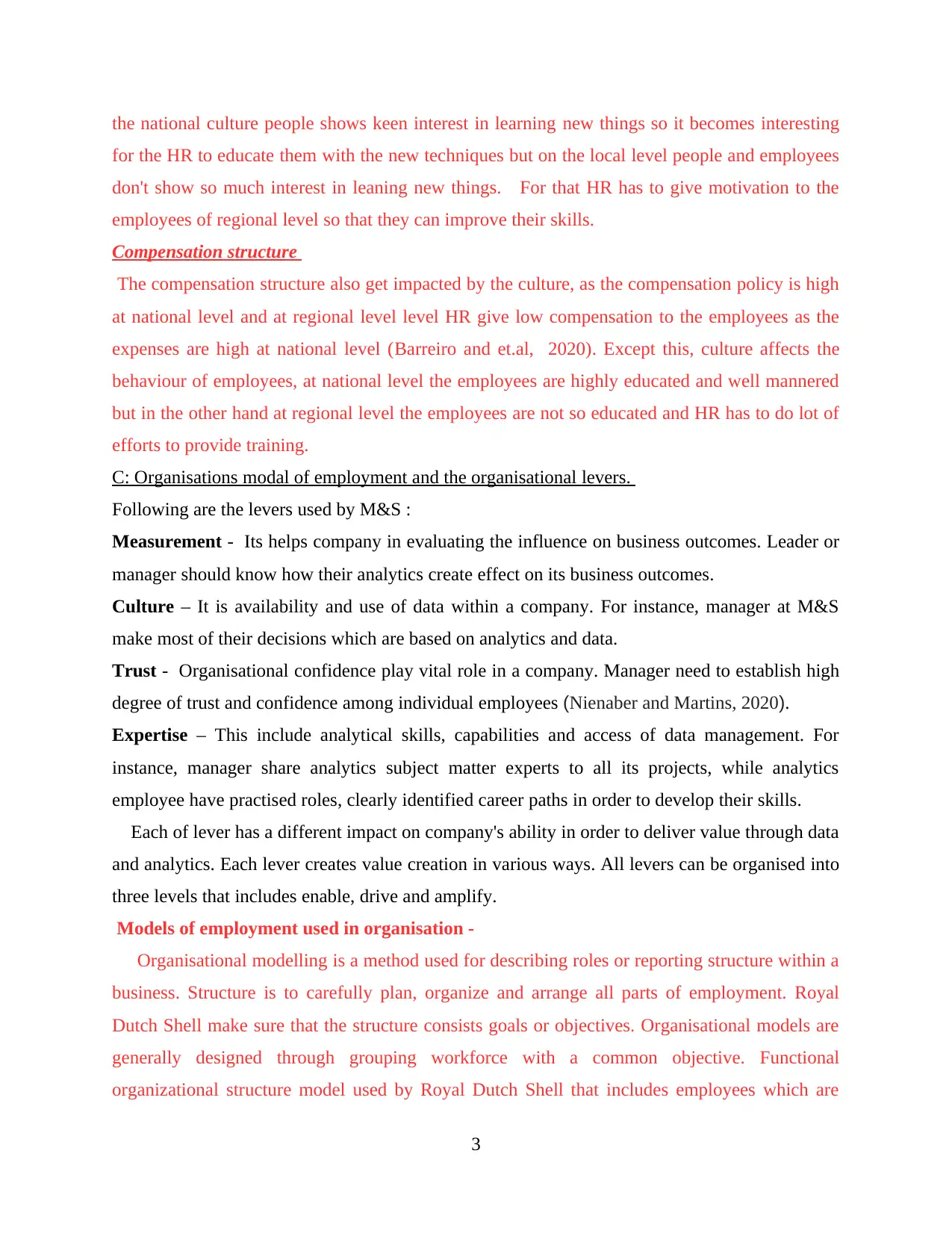
the national culture people shows keen interest in learning new things so it becomes interesting
for the HR to educate them with the new techniques but on the local level people and employees
don't show so much interest in leaning new things. For that HR has to give motivation to the
employees of regional level so that they can improve their skills.
Compensation structure
The compensation structure also get impacted by the culture, as the compensation policy is high
at national level and at regional level level HR give low compensation to the employees as the
expenses are high at national level (Barreiro and et.al, 2020). Except this, culture affects the
behaviour of employees, at national level the employees are highly educated and well mannered
but in the other hand at regional level the employees are not so educated and HR has to do lot of
efforts to provide training.
C: Organisations modal of employment and the organisational levers.
Following are the levers used by M&S :
Measurement - Its helps company in evaluating the influence on business outcomes. Leader or
manager should know how their analytics create effect on its business outcomes.
Culture – It is availability and use of data within a company. For instance, manager at M&S
make most of their decisions which are based on analytics and data.
Trust - Organisational confidence play vital role in a company. Manager need to establish high
degree of trust and confidence among individual employees (Nienaber and Martins, 2020).
Expertise – This include analytical skills, capabilities and access of data management. For
instance, manager share analytics subject matter experts to all its projects, while analytics
employee have practised roles, clearly identified career paths in order to develop their skills.
Each of lever has a different impact on company's ability in order to deliver value through data
and analytics. Each lever creates value creation in various ways. All levers can be organised into
three levels that includes enable, drive and amplify.
Models of employment used in organisation -
Organisational modelling is a method used for describing roles or reporting structure within a
business. Structure is to carefully plan, organize and arrange all parts of employment. Royal
Dutch Shell make sure that the structure consists goals or objectives. Organisational models are
generally designed through grouping workforce with a common objective. Functional
organizational structure model used by Royal Dutch Shell that includes employees which are
3
for the HR to educate them with the new techniques but on the local level people and employees
don't show so much interest in leaning new things. For that HR has to give motivation to the
employees of regional level so that they can improve their skills.
Compensation structure
The compensation structure also get impacted by the culture, as the compensation policy is high
at national level and at regional level level HR give low compensation to the employees as the
expenses are high at national level (Barreiro and et.al, 2020). Except this, culture affects the
behaviour of employees, at national level the employees are highly educated and well mannered
but in the other hand at regional level the employees are not so educated and HR has to do lot of
efforts to provide training.
C: Organisations modal of employment and the organisational levers.
Following are the levers used by M&S :
Measurement - Its helps company in evaluating the influence on business outcomes. Leader or
manager should know how their analytics create effect on its business outcomes.
Culture – It is availability and use of data within a company. For instance, manager at M&S
make most of their decisions which are based on analytics and data.
Trust - Organisational confidence play vital role in a company. Manager need to establish high
degree of trust and confidence among individual employees (Nienaber and Martins, 2020).
Expertise – This include analytical skills, capabilities and access of data management. For
instance, manager share analytics subject matter experts to all its projects, while analytics
employee have practised roles, clearly identified career paths in order to develop their skills.
Each of lever has a different impact on company's ability in order to deliver value through data
and analytics. Each lever creates value creation in various ways. All levers can be organised into
three levels that includes enable, drive and amplify.
Models of employment used in organisation -
Organisational modelling is a method used for describing roles or reporting structure within a
business. Structure is to carefully plan, organize and arrange all parts of employment. Royal
Dutch Shell make sure that the structure consists goals or objectives. Organisational models are
generally designed through grouping workforce with a common objective. Functional
organizational structure model used by Royal Dutch Shell that includes employees which are
3
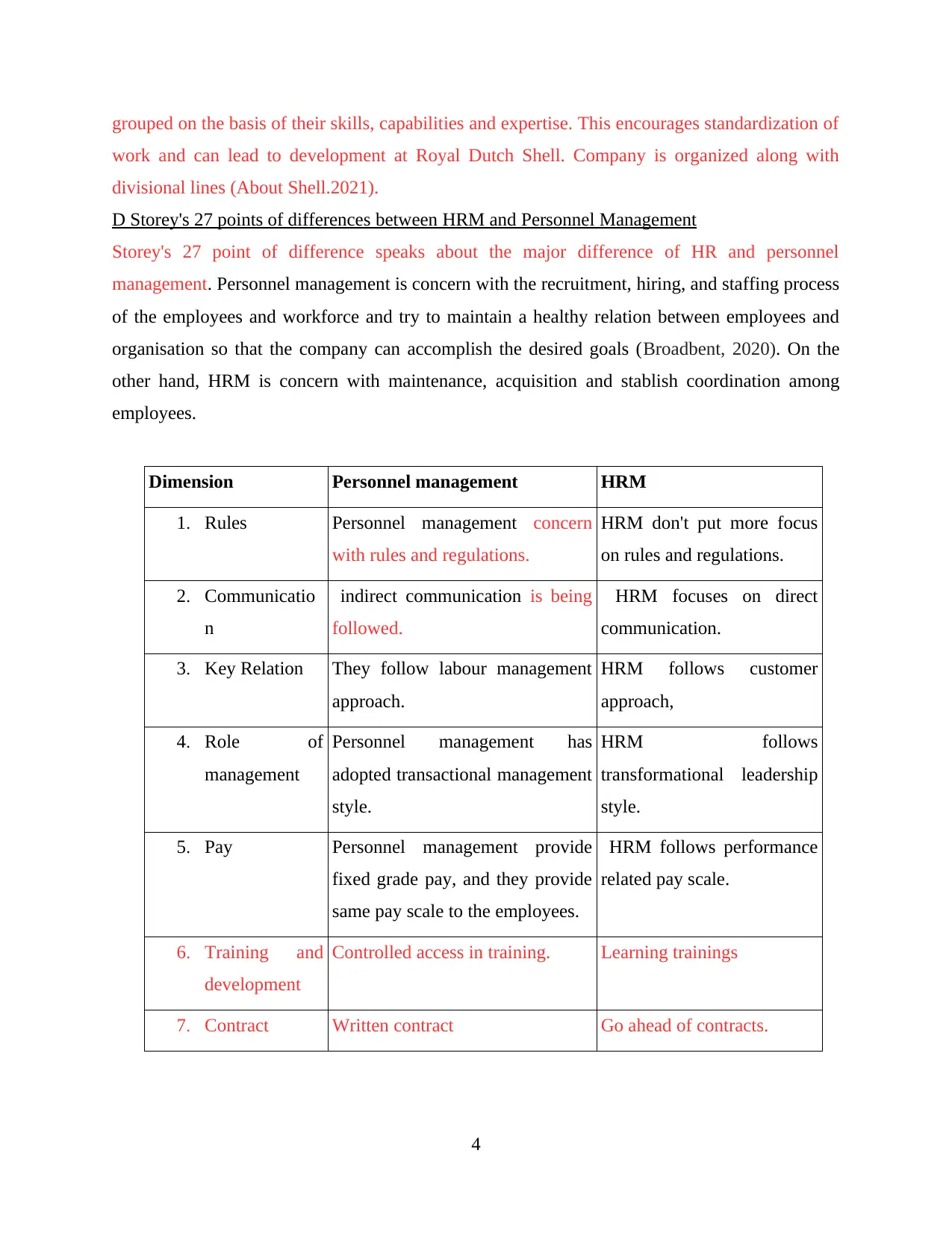
grouped on the basis of their skills, capabilities and expertise. This encourages standardization of
work and can lead to development at Royal Dutch Shell. Company is organized along with
divisional lines (About Shell.2021).
D Storey's 27 points of differences between HRM and Personnel Management
Storey's 27 point of difference speaks about the major difference of HR and personnel
management. Personnel management is concern with the recruitment, hiring, and staffing process
of the employees and workforce and try to maintain a healthy relation between employees and
organisation so that the company can accomplish the desired goals (Broadbent, 2020). On the
other hand, HRM is concern with maintenance, acquisition and stablish coordination among
employees.
Dimension Personnel management HRM
1. Rules Personnel management concern
with rules and regulations.
HRM don't put more focus
on rules and regulations.
2. Communicatio
n
indirect communication is being
followed.
HRM focuses on direct
communication.
3. Key Relation They follow labour management
approach.
HRM follows customer
approach,
4. Role of
management
Personnel management has
adopted transactional management
style.
HRM follows
transformational leadership
style.
5. Pay Personnel management provide
fixed grade pay, and they provide
same pay scale to the employees.
HRM follows performance
related pay scale.
6. Training and
development
Controlled access in training. Learning trainings
7. Contract Written contract Go ahead of contracts.
4
work and can lead to development at Royal Dutch Shell. Company is organized along with
divisional lines (About Shell.2021).
D Storey's 27 points of differences between HRM and Personnel Management
Storey's 27 point of difference speaks about the major difference of HR and personnel
management. Personnel management is concern with the recruitment, hiring, and staffing process
of the employees and workforce and try to maintain a healthy relation between employees and
organisation so that the company can accomplish the desired goals (Broadbent, 2020). On the
other hand, HRM is concern with maintenance, acquisition and stablish coordination among
employees.
Dimension Personnel management HRM
1. Rules Personnel management concern
with rules and regulations.
HRM don't put more focus
on rules and regulations.
2. Communicatio
n
indirect communication is being
followed.
HRM focuses on direct
communication.
3. Key Relation They follow labour management
approach.
HRM follows customer
approach,
4. Role of
management
Personnel management has
adopted transactional management
style.
HRM follows
transformational leadership
style.
5. Pay Personnel management provide
fixed grade pay, and they provide
same pay scale to the employees.
HRM follows performance
related pay scale.
6. Training and
development
Controlled access in training. Learning trainings
7. Contract Written contract Go ahead of contracts.
4
⊘ This is a preview!⊘
Do you want full access?
Subscribe today to unlock all pages.

Trusted by 1+ million students worldwide
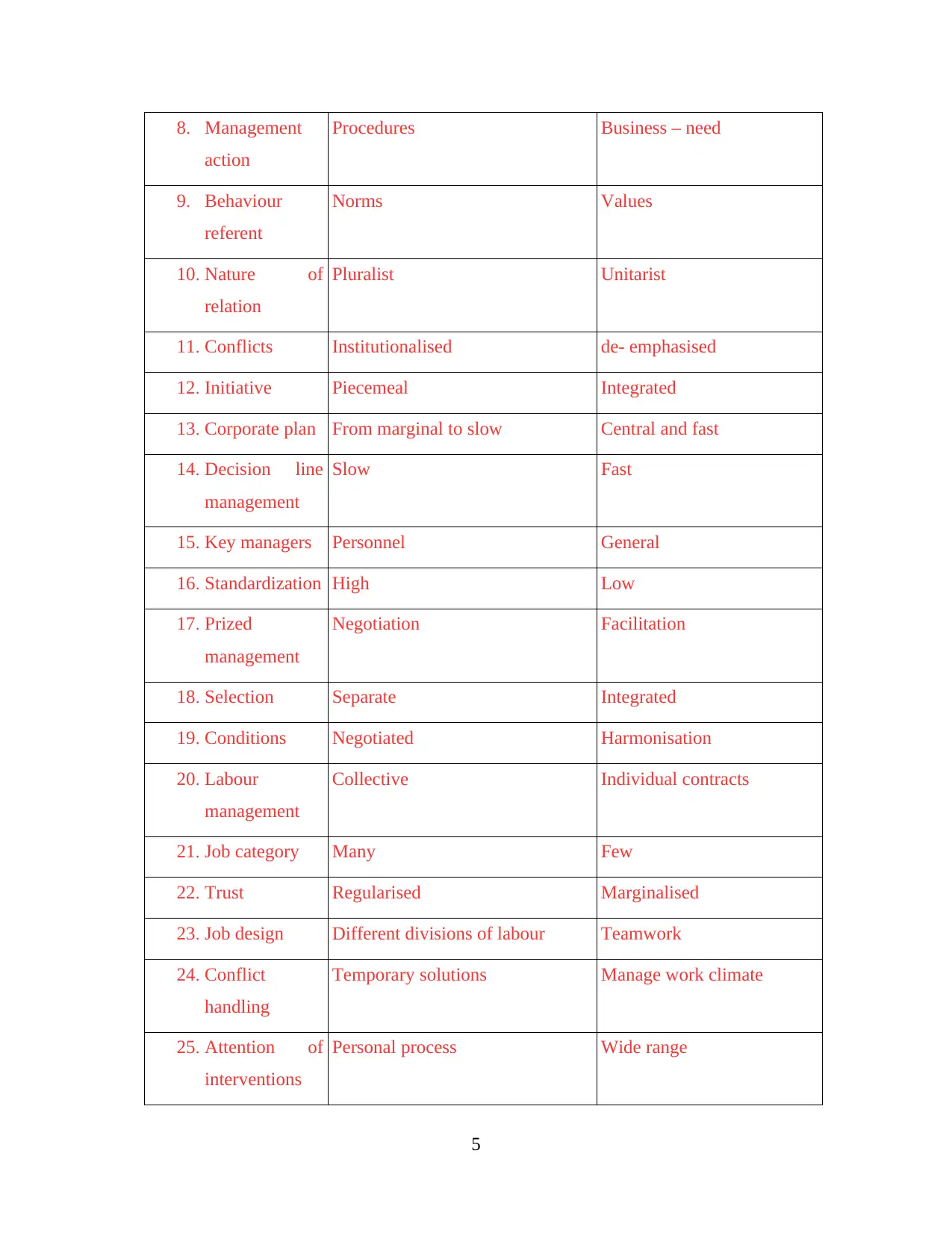
8. Management
action
Procedures Business – need
9. Behaviour
referent
Norms Values
10. Nature of
relation
Pluralist Unitarist
11. Conflicts Institutionalised de- emphasised
12. Initiative Piecemeal Integrated
13. Corporate plan From marginal to slow Central and fast
14. Decision line
management
Slow Fast
15. Key managers Personnel General
16. Standardization High Low
17. Prized
management
Negotiation Facilitation
18. Selection Separate Integrated
19. Conditions Negotiated Harmonisation
20. Labour
management
Collective Individual contracts
21. Job category Many Few
22. Trust Regularised Marginalised
23. Job design Different divisions of labour Teamwork
24. Conflict
handling
Temporary solutions Manage work climate
25. Attention of
interventions
Personal process Wide range
5
action
Procedures Business – need
9. Behaviour
referent
Norms Values
10. Nature of
relation
Pluralist Unitarist
11. Conflicts Institutionalised de- emphasised
12. Initiative Piecemeal Integrated
13. Corporate plan From marginal to slow Central and fast
14. Decision line
management
Slow Fast
15. Key managers Personnel General
16. Standardization High Low
17. Prized
management
Negotiation Facilitation
18. Selection Separate Integrated
19. Conditions Negotiated Harmonisation
20. Labour
management
Collective Individual contracts
21. Job category Many Few
22. Trust Regularised Marginalised
23. Job design Different divisions of labour Teamwork
24. Conflict
handling
Temporary solutions Manage work climate
25. Attention of
interventions
Personal process Wide range
5
Paraphrase This Document
Need a fresh take? Get an instant paraphrase of this document with our AI Paraphraser
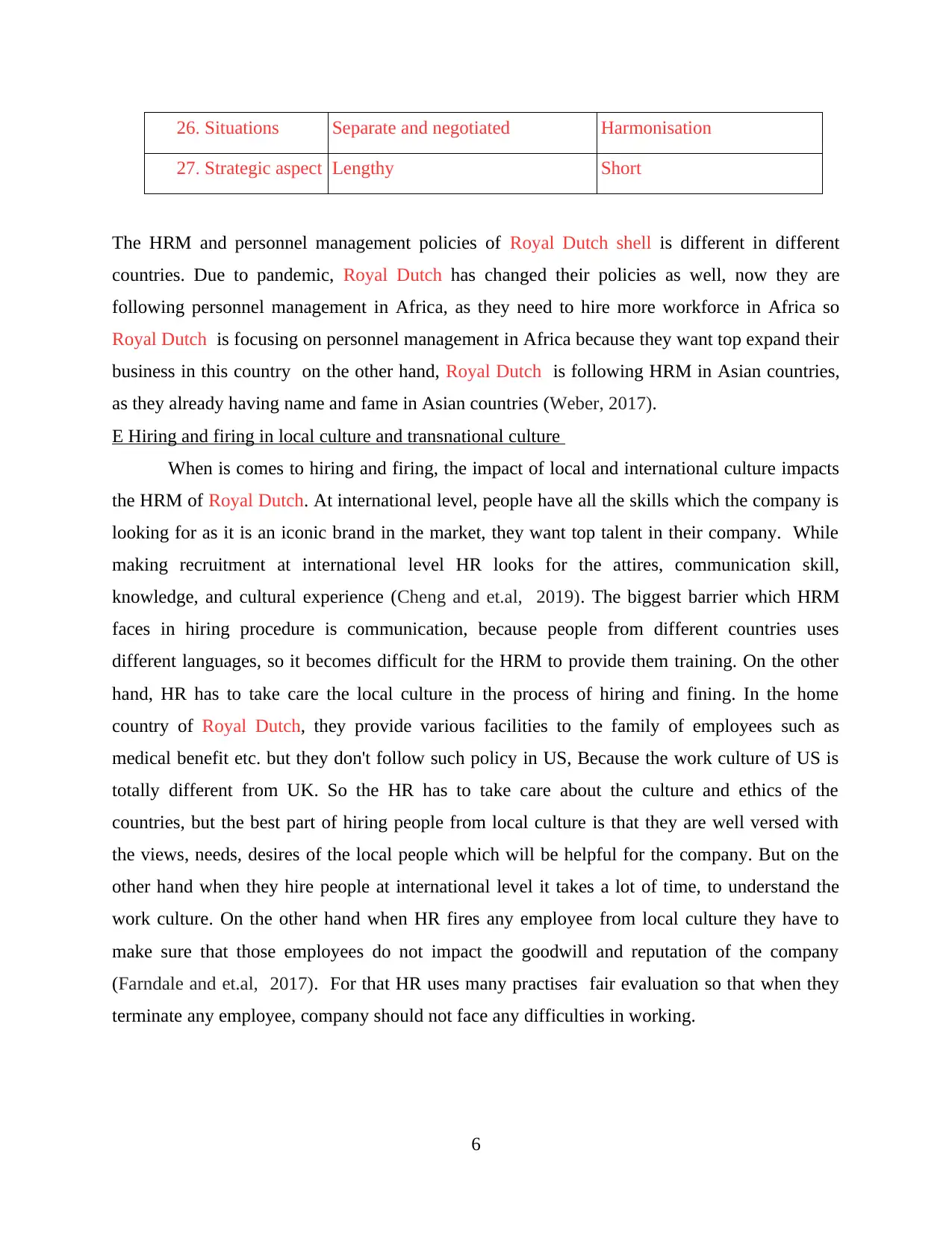
26. Situations Separate and negotiated Harmonisation
27. Strategic aspect Lengthy Short
The HRM and personnel management policies of Royal Dutch shell is different in different
countries. Due to pandemic, Royal Dutch has changed their policies as well, now they are
following personnel management in Africa, as they need to hire more workforce in Africa so
Royal Dutch is focusing on personnel management in Africa because they want top expand their
business in this country on the other hand, Royal Dutch is following HRM in Asian countries,
as they already having name and fame in Asian countries (Weber, 2017).
E Hiring and firing in local culture and transnational culture
When is comes to hiring and firing, the impact of local and international culture impacts
the HRM of Royal Dutch. At international level, people have all the skills which the company is
looking for as it is an iconic brand in the market, they want top talent in their company. While
making recruitment at international level HR looks for the attires, communication skill,
knowledge, and cultural experience (Cheng and et.al, 2019). The biggest barrier which HRM
faces in hiring procedure is communication, because people from different countries uses
different languages, so it becomes difficult for the HRM to provide them training. On the other
hand, HR has to take care the local culture in the process of hiring and fining. In the home
country of Royal Dutch, they provide various facilities to the family of employees such as
medical benefit etc. but they don't follow such policy in US, Because the work culture of US is
totally different from UK. So the HR has to take care about the culture and ethics of the
countries, but the best part of hiring people from local culture is that they are well versed with
the views, needs, desires of the local people which will be helpful for the company. But on the
other hand when they hire people at international level it takes a lot of time, to understand the
work culture. On the other hand when HR fires any employee from local culture they have to
make sure that those employees do not impact the goodwill and reputation of the company
(Farndale and et.al, 2017). For that HR uses many practises fair evaluation so that when they
terminate any employee, company should not face any difficulties in working.
6
27. Strategic aspect Lengthy Short
The HRM and personnel management policies of Royal Dutch shell is different in different
countries. Due to pandemic, Royal Dutch has changed their policies as well, now they are
following personnel management in Africa, as they need to hire more workforce in Africa so
Royal Dutch is focusing on personnel management in Africa because they want top expand their
business in this country on the other hand, Royal Dutch is following HRM in Asian countries,
as they already having name and fame in Asian countries (Weber, 2017).
E Hiring and firing in local culture and transnational culture
When is comes to hiring and firing, the impact of local and international culture impacts
the HRM of Royal Dutch. At international level, people have all the skills which the company is
looking for as it is an iconic brand in the market, they want top talent in their company. While
making recruitment at international level HR looks for the attires, communication skill,
knowledge, and cultural experience (Cheng and et.al, 2019). The biggest barrier which HRM
faces in hiring procedure is communication, because people from different countries uses
different languages, so it becomes difficult for the HRM to provide them training. On the other
hand, HR has to take care the local culture in the process of hiring and fining. In the home
country of Royal Dutch, they provide various facilities to the family of employees such as
medical benefit etc. but they don't follow such policy in US, Because the work culture of US is
totally different from UK. So the HR has to take care about the culture and ethics of the
countries, but the best part of hiring people from local culture is that they are well versed with
the views, needs, desires of the local people which will be helpful for the company. But on the
other hand when they hire people at international level it takes a lot of time, to understand the
work culture. On the other hand when HR fires any employee from local culture they have to
make sure that those employees do not impact the goodwill and reputation of the company
(Farndale and et.al, 2017). For that HR uses many practises fair evaluation so that when they
terminate any employee, company should not face any difficulties in working.
6
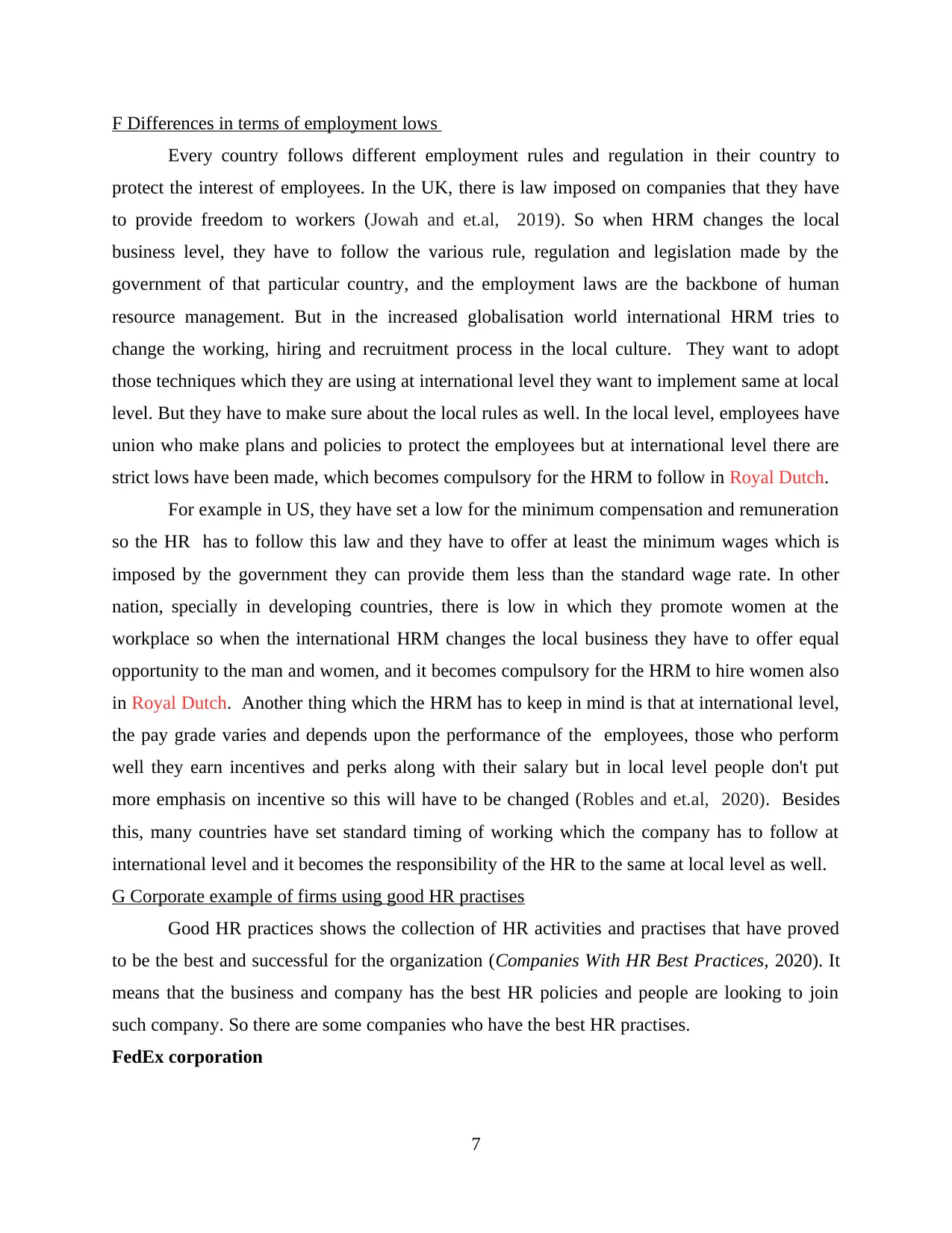
F Differences in terms of employment lows
Every country follows different employment rules and regulation in their country to
protect the interest of employees. In the UK, there is law imposed on companies that they have
to provide freedom to workers (Jowah and et.al, 2019). So when HRM changes the local
business level, they have to follow the various rule, regulation and legislation made by the
government of that particular country, and the employment laws are the backbone of human
resource management. But in the increased globalisation world international HRM tries to
change the working, hiring and recruitment process in the local culture. They want to adopt
those techniques which they are using at international level they want to implement same at local
level. But they have to make sure about the local rules as well. In the local level, employees have
union who make plans and policies to protect the employees but at international level there are
strict lows have been made, which becomes compulsory for the HRM to follow in Royal Dutch.
For example in US, they have set a low for the minimum compensation and remuneration
so the HR has to follow this law and they have to offer at least the minimum wages which is
imposed by the government they can provide them less than the standard wage rate. In other
nation, specially in developing countries, there is low in which they promote women at the
workplace so when the international HRM changes the local business they have to offer equal
opportunity to the man and women, and it becomes compulsory for the HRM to hire women also
in Royal Dutch. Another thing which the HRM has to keep in mind is that at international level,
the pay grade varies and depends upon the performance of the employees, those who perform
well they earn incentives and perks along with their salary but in local level people don't put
more emphasis on incentive so this will have to be changed (Robles and et.al, 2020). Besides
this, many countries have set standard timing of working which the company has to follow at
international level and it becomes the responsibility of the HR to the same at local level as well.
G Corporate example of firms using good HR practises
Good HR practices shows the collection of HR activities and practises that have proved
to be the best and successful for the organization (Companies With HR Best Practices, 2020). It
means that the business and company has the best HR policies and people are looking to join
such company. So there are some companies who have the best HR practises.
FedEx corporation
7
Every country follows different employment rules and regulation in their country to
protect the interest of employees. In the UK, there is law imposed on companies that they have
to provide freedom to workers (Jowah and et.al, 2019). So when HRM changes the local
business level, they have to follow the various rule, regulation and legislation made by the
government of that particular country, and the employment laws are the backbone of human
resource management. But in the increased globalisation world international HRM tries to
change the working, hiring and recruitment process in the local culture. They want to adopt
those techniques which they are using at international level they want to implement same at local
level. But they have to make sure about the local rules as well. In the local level, employees have
union who make plans and policies to protect the employees but at international level there are
strict lows have been made, which becomes compulsory for the HRM to follow in Royal Dutch.
For example in US, they have set a low for the minimum compensation and remuneration
so the HR has to follow this law and they have to offer at least the minimum wages which is
imposed by the government they can provide them less than the standard wage rate. In other
nation, specially in developing countries, there is low in which they promote women at the
workplace so when the international HRM changes the local business they have to offer equal
opportunity to the man and women, and it becomes compulsory for the HRM to hire women also
in Royal Dutch. Another thing which the HRM has to keep in mind is that at international level,
the pay grade varies and depends upon the performance of the employees, those who perform
well they earn incentives and perks along with their salary but in local level people don't put
more emphasis on incentive so this will have to be changed (Robles and et.al, 2020). Besides
this, many countries have set standard timing of working which the company has to follow at
international level and it becomes the responsibility of the HR to the same at local level as well.
G Corporate example of firms using good HR practises
Good HR practices shows the collection of HR activities and practises that have proved
to be the best and successful for the organization (Companies With HR Best Practices, 2020). It
means that the business and company has the best HR policies and people are looking to join
such company. So there are some companies who have the best HR practises.
FedEx corporation
7
⊘ This is a preview!⊘
Do you want full access?
Subscribe today to unlock all pages.

Trusted by 1+ million students worldwide
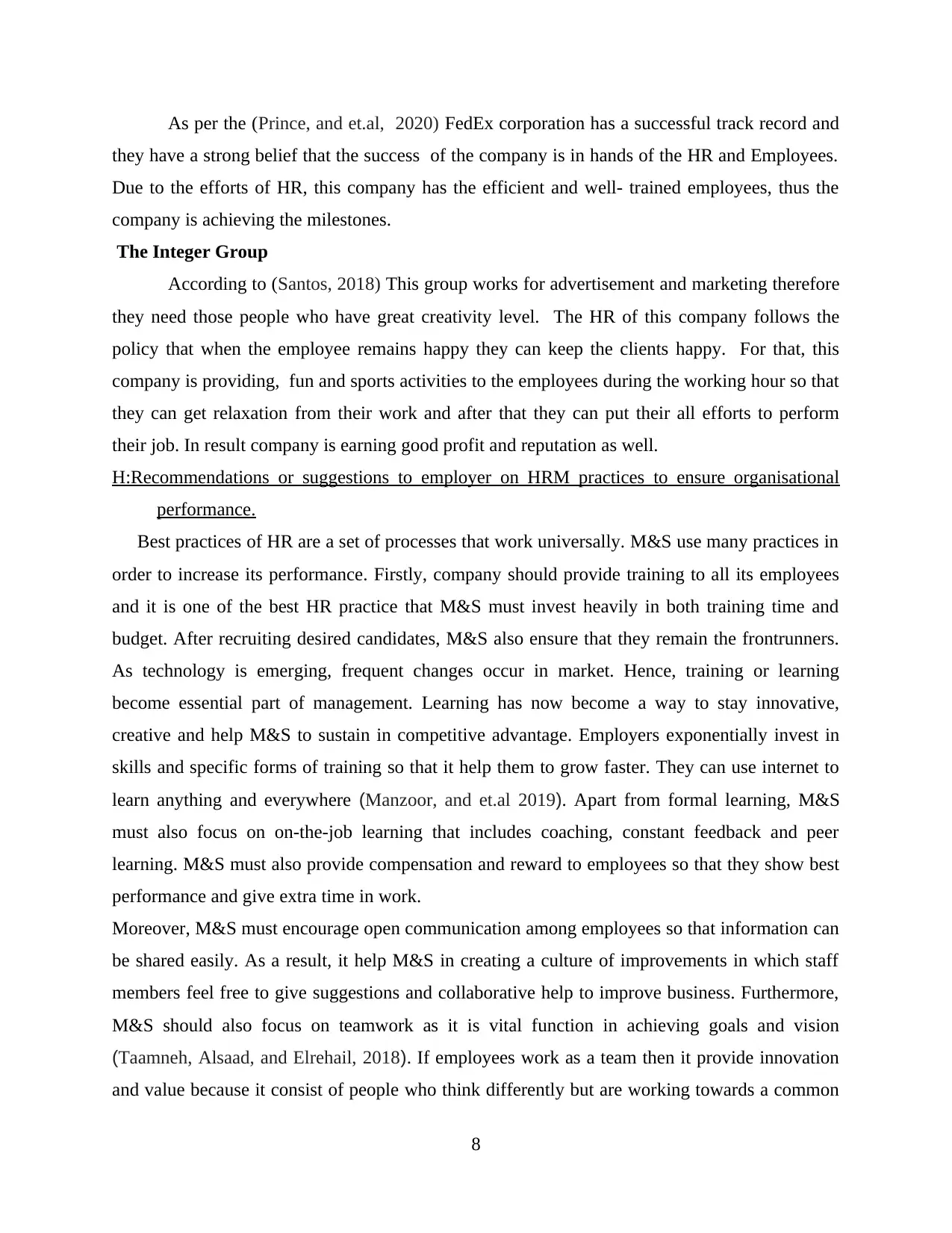
As per the (Prince, and et.al, 2020) FedEx corporation has a successful track record and
they have a strong belief that the success of the company is in hands of the HR and Employees.
Due to the efforts of HR, this company has the efficient and well- trained employees, thus the
company is achieving the milestones.
The Integer Group
According to (Santos, 2018) This group works for advertisement and marketing therefore
they need those people who have great creativity level. The HR of this company follows the
policy that when the employee remains happy they can keep the clients happy. For that, this
company is providing, fun and sports activities to the employees during the working hour so that
they can get relaxation from their work and after that they can put their all efforts to perform
their job. In result company is earning good profit and reputation as well.
H:Recommendations or suggestions to employer on HRM practices to ensure organisational
performance.
Best practices of HR are a set of processes that work universally. M&S use many practices in
order to increase its performance. Firstly, company should provide training to all its employees
and it is one of the best HR practice that M&S must invest heavily in both training time and
budget. After recruiting desired candidates, M&S also ensure that they remain the frontrunners.
As technology is emerging, frequent changes occur in market. Hence, training or learning
become essential part of management. Learning has now become a way to stay innovative,
creative and help M&S to sustain in competitive advantage. Employers exponentially invest in
skills and specific forms of training so that it help them to grow faster. They can use internet to
learn anything and everywhere (Manzoor, and et.al 2019). Apart from formal learning, M&S
must also focus on on-the-job learning that includes coaching, constant feedback and peer
learning. M&S must also provide compensation and reward to employees so that they show best
performance and give extra time in work.
Moreover, M&S must encourage open communication among employees so that information can
be shared easily. As a result, it help M&S in creating a culture of improvements in which staff
members feel free to give suggestions and collaborative help to improve business. Furthermore,
M&S should also focus on teamwork as it is vital function in achieving goals and vision
(Taamneh, Alsaad, and Elrehail, 2018). If employees work as a team then it provide innovation
and value because it consist of people who think differently but are working towards a common
8
they have a strong belief that the success of the company is in hands of the HR and Employees.
Due to the efforts of HR, this company has the efficient and well- trained employees, thus the
company is achieving the milestones.
The Integer Group
According to (Santos, 2018) This group works for advertisement and marketing therefore
they need those people who have great creativity level. The HR of this company follows the
policy that when the employee remains happy they can keep the clients happy. For that, this
company is providing, fun and sports activities to the employees during the working hour so that
they can get relaxation from their work and after that they can put their all efforts to perform
their job. In result company is earning good profit and reputation as well.
H:Recommendations or suggestions to employer on HRM practices to ensure organisational
performance.
Best practices of HR are a set of processes that work universally. M&S use many practices in
order to increase its performance. Firstly, company should provide training to all its employees
and it is one of the best HR practice that M&S must invest heavily in both training time and
budget. After recruiting desired candidates, M&S also ensure that they remain the frontrunners.
As technology is emerging, frequent changes occur in market. Hence, training or learning
become essential part of management. Learning has now become a way to stay innovative,
creative and help M&S to sustain in competitive advantage. Employers exponentially invest in
skills and specific forms of training so that it help them to grow faster. They can use internet to
learn anything and everywhere (Manzoor, and et.al 2019). Apart from formal learning, M&S
must also focus on on-the-job learning that includes coaching, constant feedback and peer
learning. M&S must also provide compensation and reward to employees so that they show best
performance and give extra time in work.
Moreover, M&S must encourage open communication among employees so that information can
be shared easily. As a result, it help M&S in creating a culture of improvements in which staff
members feel free to give suggestions and collaborative help to improve business. Furthermore,
M&S should also focus on teamwork as it is vital function in achieving goals and vision
(Taamneh, Alsaad, and Elrehail, 2018). If employees work as a team then it provide innovation
and value because it consist of people who think differently but are working towards a common
8
Paraphrase This Document
Need a fresh take? Get an instant paraphrase of this document with our AI Paraphraser
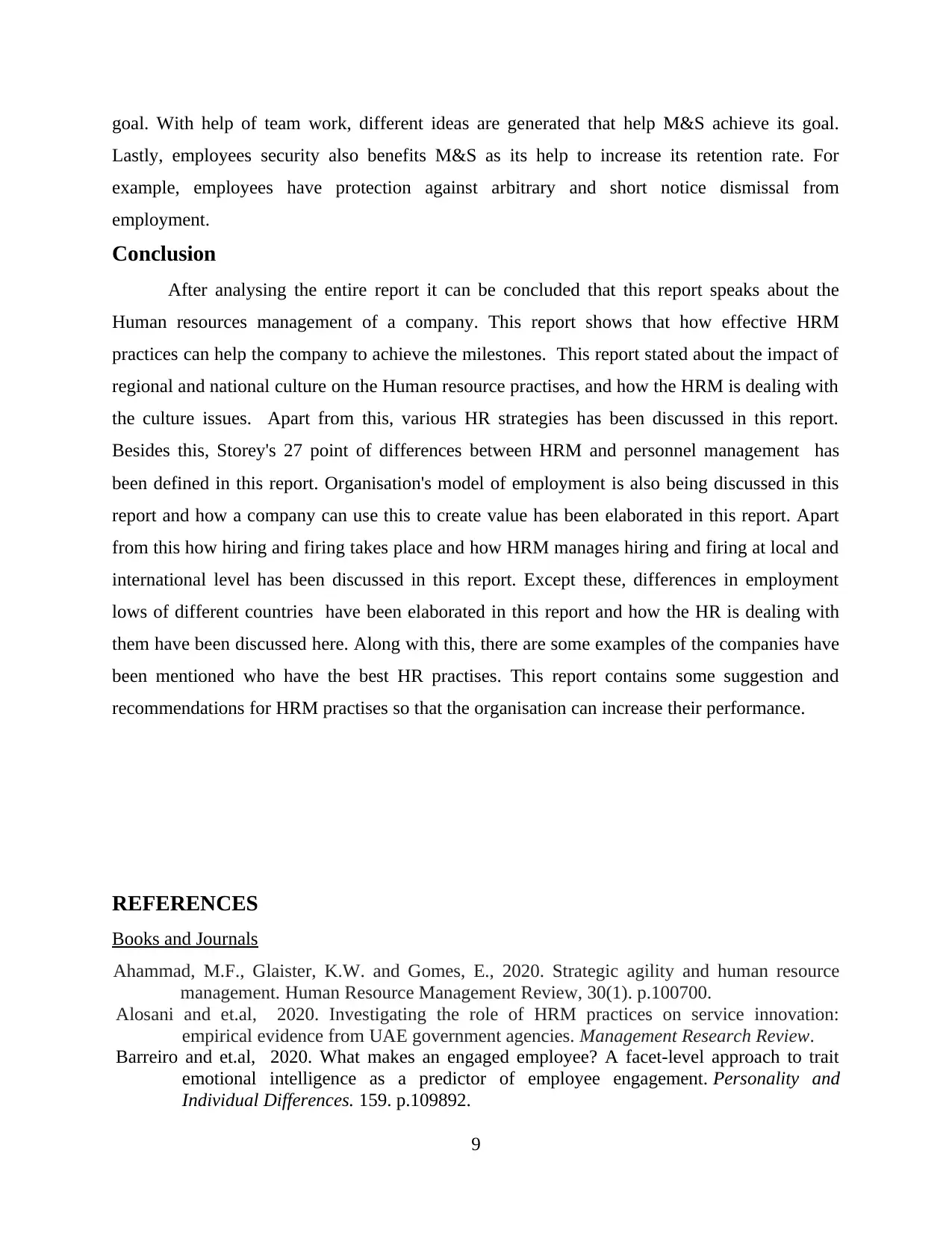
goal. With help of team work, different ideas are generated that help M&S achieve its goal.
Lastly, employees security also benefits M&S as its help to increase its retention rate. For
example, employees have protection against arbitrary and short notice dismissal from
employment.
Conclusion
After analysing the entire report it can be concluded that this report speaks about the
Human resources management of a company. This report shows that how effective HRM
practices can help the company to achieve the milestones. This report stated about the impact of
regional and national culture on the Human resource practises, and how the HRM is dealing with
the culture issues. Apart from this, various HR strategies has been discussed in this report.
Besides this, Storey's 27 point of differences between HRM and personnel management has
been defined in this report. Organisation's model of employment is also being discussed in this
report and how a company can use this to create value has been elaborated in this report. Apart
from this how hiring and firing takes place and how HRM manages hiring and firing at local and
international level has been discussed in this report. Except these, differences in employment
lows of different countries have been elaborated in this report and how the HR is dealing with
them have been discussed here. Along with this, there are some examples of the companies have
been mentioned who have the best HR practises. This report contains some suggestion and
recommendations for HRM practises so that the organisation can increase their performance.
REFERENCES
Books and Journals
Ahammad, M.F., Glaister, K.W. and Gomes, E., 2020. Strategic agility and human resource
management. Human Resource Management Review, 30(1). p.100700.
Alosani and et.al, 2020. Investigating the role of HRM practices on service innovation:
empirical evidence from UAE government agencies. Management Research Review.
Barreiro and et.al, 2020. What makes an engaged employee? A facet-level approach to trait
emotional intelligence as a predictor of employee engagement. Personality and
Individual Differences. 159. p.109892.
9
Lastly, employees security also benefits M&S as its help to increase its retention rate. For
example, employees have protection against arbitrary and short notice dismissal from
employment.
Conclusion
After analysing the entire report it can be concluded that this report speaks about the
Human resources management of a company. This report shows that how effective HRM
practices can help the company to achieve the milestones. This report stated about the impact of
regional and national culture on the Human resource practises, and how the HRM is dealing with
the culture issues. Apart from this, various HR strategies has been discussed in this report.
Besides this, Storey's 27 point of differences between HRM and personnel management has
been defined in this report. Organisation's model of employment is also being discussed in this
report and how a company can use this to create value has been elaborated in this report. Apart
from this how hiring and firing takes place and how HRM manages hiring and firing at local and
international level has been discussed in this report. Except these, differences in employment
lows of different countries have been elaborated in this report and how the HR is dealing with
them have been discussed here. Along with this, there are some examples of the companies have
been mentioned who have the best HR practises. This report contains some suggestion and
recommendations for HRM practises so that the organisation can increase their performance.
REFERENCES
Books and Journals
Ahammad, M.F., Glaister, K.W. and Gomes, E., 2020. Strategic agility and human resource
management. Human Resource Management Review, 30(1). p.100700.
Alosani and et.al, 2020. Investigating the role of HRM practices on service innovation:
empirical evidence from UAE government agencies. Management Research Review.
Barreiro and et.al, 2020. What makes an engaged employee? A facet-level approach to trait
emotional intelligence as a predictor of employee engagement. Personality and
Individual Differences. 159. p.109892.
9
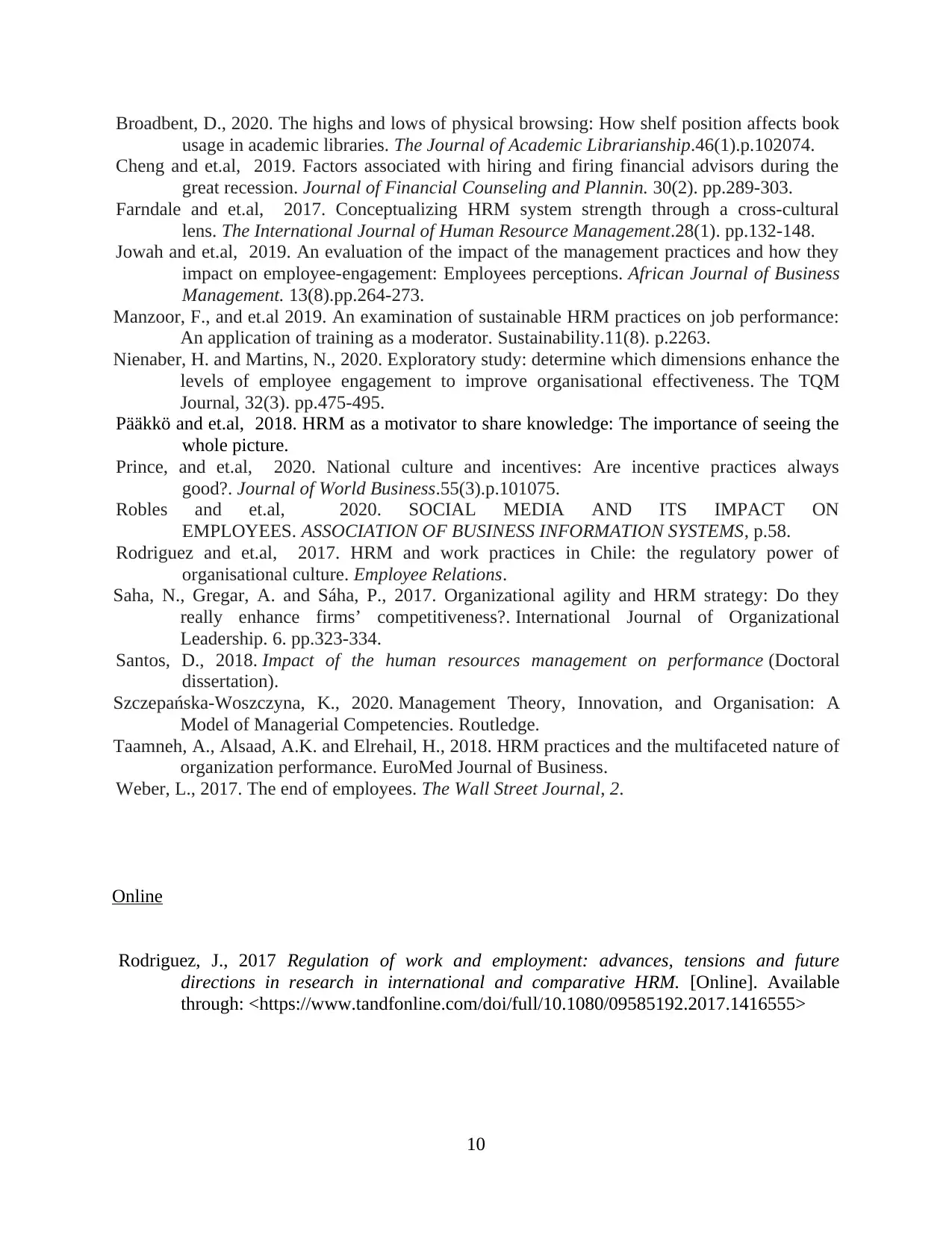
Broadbent, D., 2020. The highs and lows of physical browsing: How shelf position affects book
usage in academic libraries. The Journal of Academic Librarianship.46(1).p.102074.
Cheng and et.al, 2019. Factors associated with hiring and firing financial advisors during the
great recession. Journal of Financial Counseling and Plannin. 30(2). pp.289-303.
Farndale and et.al, 2017. Conceptualizing HRM system strength through a cross-cultural
lens. The International Journal of Human Resource Management.28(1). pp.132-148.
Jowah and et.al, 2019. An evaluation of the impact of the management practices and how they
impact on employee-engagement: Employees perceptions. African Journal of Business
Management. 13(8).pp.264-273.
Manzoor, F., and et.al 2019. An examination of sustainable HRM practices on job performance:
An application of training as a moderator. Sustainability.11(8). p.2263.
Nienaber, H. and Martins, N., 2020. Exploratory study: determine which dimensions enhance the
levels of employee engagement to improve organisational effectiveness. The TQM
Journal, 32(3). pp.475-495.
Pääkkö and et.al, 2018. HRM as a motivator to share knowledge: The importance of seeing the
whole picture.
Prince, and et.al, 2020. National culture and incentives: Are incentive practices always
good?. Journal of World Business.55(3).p.101075.
Robles and et.al, 2020. SOCIAL MEDIA AND ITS IMPACT ON
EMPLOYEES. ASSOCIATION OF BUSINESS INFORMATION SYSTEMS, p.58.
Rodriguez and et.al, 2017. HRM and work practices in Chile: the regulatory power of
organisational culture. Employee Relations.
Saha, N., Gregar, A. and Sáha, P., 2017. Organizational agility and HRM strategy: Do they
really enhance firms’ competitiveness?. International Journal of Organizational
Leadership. 6. pp.323-334.
Santos, D., 2018. Impact of the human resources management on performance (Doctoral
dissertation).
Szczepańska-Woszczyna, K., 2020. Management Theory, Innovation, and Organisation: A
Model of Managerial Competencies. Routledge.
Taamneh, A., Alsaad, A.K. and Elrehail, H., 2018. HRM practices and the multifaceted nature of
organization performance. EuroMed Journal of Business.
Weber, L., 2017. The end of employees. The Wall Street Journal, 2.
Online
Rodriguez, J., 2017 Regulation of work and employment: advances, tensions and future
directions in research in international and comparative HRM. [Online]. Available
through: <https://www.tandfonline.com/doi/full/10.1080/09585192.2017.1416555>
10
usage in academic libraries. The Journal of Academic Librarianship.46(1).p.102074.
Cheng and et.al, 2019. Factors associated with hiring and firing financial advisors during the
great recession. Journal of Financial Counseling and Plannin. 30(2). pp.289-303.
Farndale and et.al, 2017. Conceptualizing HRM system strength through a cross-cultural
lens. The International Journal of Human Resource Management.28(1). pp.132-148.
Jowah and et.al, 2019. An evaluation of the impact of the management practices and how they
impact on employee-engagement: Employees perceptions. African Journal of Business
Management. 13(8).pp.264-273.
Manzoor, F., and et.al 2019. An examination of sustainable HRM practices on job performance:
An application of training as a moderator. Sustainability.11(8). p.2263.
Nienaber, H. and Martins, N., 2020. Exploratory study: determine which dimensions enhance the
levels of employee engagement to improve organisational effectiveness. The TQM
Journal, 32(3). pp.475-495.
Pääkkö and et.al, 2018. HRM as a motivator to share knowledge: The importance of seeing the
whole picture.
Prince, and et.al, 2020. National culture and incentives: Are incentive practices always
good?. Journal of World Business.55(3).p.101075.
Robles and et.al, 2020. SOCIAL MEDIA AND ITS IMPACT ON
EMPLOYEES. ASSOCIATION OF BUSINESS INFORMATION SYSTEMS, p.58.
Rodriguez and et.al, 2017. HRM and work practices in Chile: the regulatory power of
organisational culture. Employee Relations.
Saha, N., Gregar, A. and Sáha, P., 2017. Organizational agility and HRM strategy: Do they
really enhance firms’ competitiveness?. International Journal of Organizational
Leadership. 6. pp.323-334.
Santos, D., 2018. Impact of the human resources management on performance (Doctoral
dissertation).
Szczepańska-Woszczyna, K., 2020. Management Theory, Innovation, and Organisation: A
Model of Managerial Competencies. Routledge.
Taamneh, A., Alsaad, A.K. and Elrehail, H., 2018. HRM practices and the multifaceted nature of
organization performance. EuroMed Journal of Business.
Weber, L., 2017. The end of employees. The Wall Street Journal, 2.
Online
Rodriguez, J., 2017 Regulation of work and employment: advances, tensions and future
directions in research in international and comparative HRM. [Online]. Available
through: <https://www.tandfonline.com/doi/full/10.1080/09585192.2017.1416555>
10
⊘ This is a preview!⊘
Do you want full access?
Subscribe today to unlock all pages.

Trusted by 1+ million students worldwide
1 out of 16
Related Documents
Your All-in-One AI-Powered Toolkit for Academic Success.
+13062052269
info@desklib.com
Available 24*7 on WhatsApp / Email
![[object Object]](/_next/static/media/star-bottom.7253800d.svg)
Unlock your academic potential
Copyright © 2020–2025 A2Z Services. All Rights Reserved. Developed and managed by ZUCOL.



